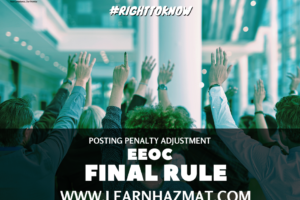Businesses Don’t Always Know What Qualifies as a Dangerous Good
Not all hazardous materials are created equal, but all must be treated with respect. It is important to understand the classifications of these dangerous goods and how to safely and properly handle each. This article will briefly explain the nine classes that hazardous materials fall into, as listed by the Pipeline and Hazardous Material Safety Administration ( PHMSA).
Class 1: Explosives
The danger with explosives is obvious. If handled improperly, extreme and massive damage can be caused, as well as severe personal injury. Much like any other form of dangerous goods, explosives come in different forms and present different safety risks. Explosives are broken down into six divisions of hazard, according to the PHMSA. The divisions range from mass explosion hazards, where the entire load is at risk of instantaneous detonation, to extremely insensitive substances, which demonstrate a negligible probability of exploding accidentally. It is of utmost importance that the handler of these materials understands the risks associated.
Class 2: Gases
Gases are divided into three divisions: flammable, non-flammable and non-toxic, and toxic. Compressed gases, pressurized cryogenic liquids, gases dissolved under pressure, and liquefied gases fall into these categories. Each division comes with its own set of associated risks. When handling and transporting gases it is important to understand which division the gas is associated with and take the proper safety measures.
Class 3: Flammable Liquids
This class covers liquids with a flash point of 140 degrees Fahrenheit or lower. A liquid’s flash point is the lowest temperature at which it will produce a “vapor in the air near its surface that will ‘flash,’ or briefly ignite, on exposure to an open flame,” according to the Encyclopedia Britannica. Basically, the lower the flash point, the more flammable the liquid is.
Class 4: Flammable Solids
This classification includes solid materials that are readily combustible. They can burn in an unaltered state, without any accelerants, and may burst into flame from friction alone. Examples include matches and sulfur. There are proper procedures to follow when transporting such material so as to keep safety risks at a minimum. Class 4 includes desensitized explosives and self-reactive material liquids or solids.
Class 5: Oxidizing Substances and Organic Peroxides
Oxidizers are hazardous because they can cause the combustion of other materials, chiefly by supplying oxygen. Organic peroxides are thermally unstable substances, which may exothermic decompose.
Class 6: Poisonous (Toxic) and Infectious Substances
According to the U.S. transportation code, poisonous materials are any non-gas that can be so toxic to humans as to afford a hazard to health during transportation. It’s also possible to classify a material as poisonous by testing it. Infectious substances contain or are expected to contain pathogens.
Class 7: Radioactive Material
The transportation of radioactive material takes careful planning. Per the Federal Motor Carrier Safety Administration, transporters must take special care to secure the material and transport it along routes that minimize radiological risk. They also require special hazardous materials transportation training.
Tag:hazardous materials, PHMSA





